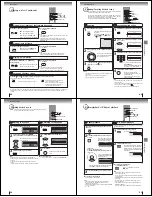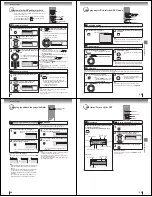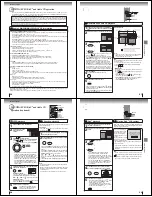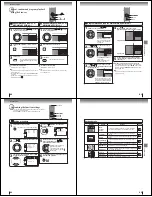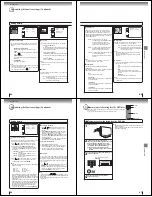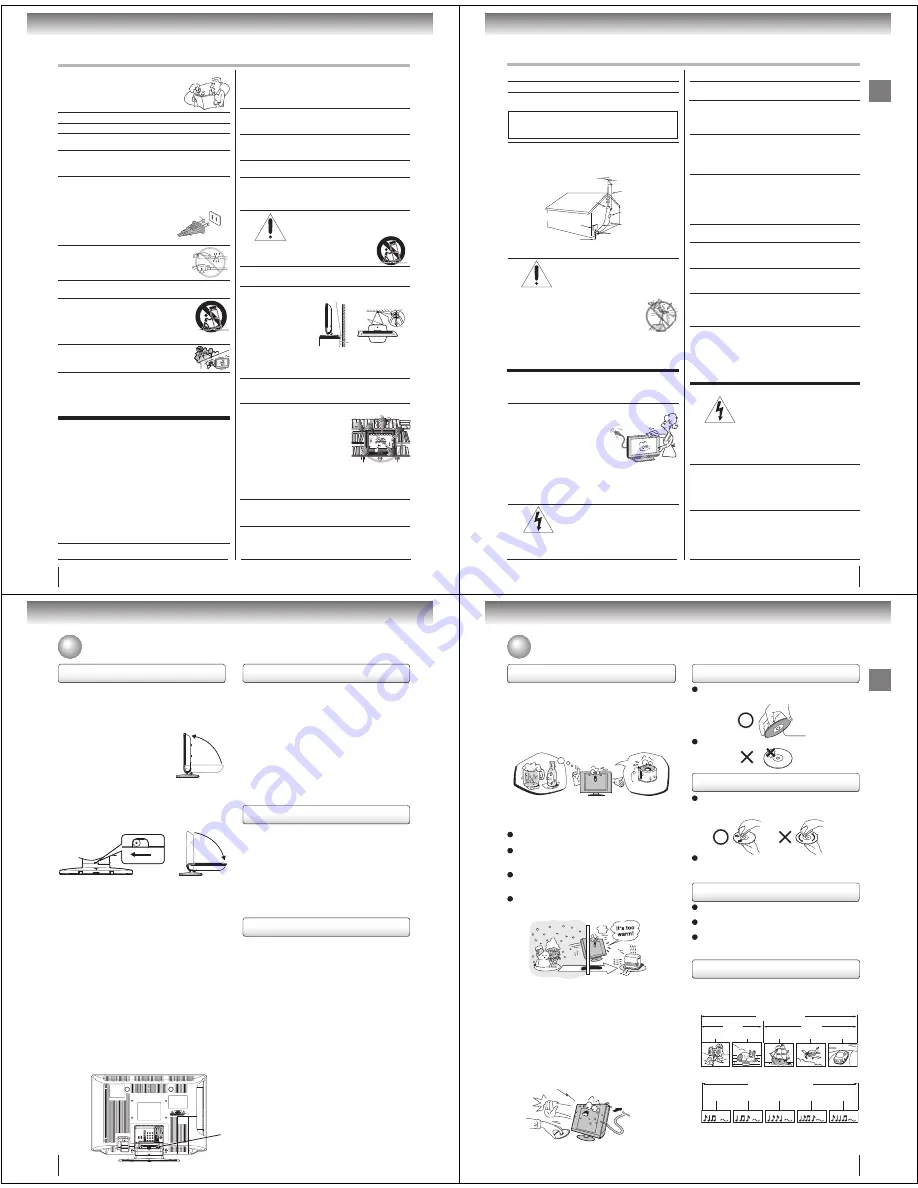
Introduction
4
SAFETY INSTRUCTIONS
16) To avoid damage to this product, never place or
store the TV in direct sunlight; hot, humid areas;
or areas subject to excessive dust or vibration.
17) ALWAYS plug the product into an outlet that is located
in such a manner that it can be easily unplugged in
case the product requires service.
18) NEVER route the products power cord inside a wall
or similar enclosed area.
19) Never modify this equipment. Changes or modi cations
may void: a) the warranty, and b) the users authority to
operate this equipment under the rules of the
Federal Communications Commission.
20)
DANGER: RISK OF SERIOUS
PERSONAL INJURY, DEATH, OR
EQUIPMENT DAMAGE!
Never place
the TV on an unstable cart,
stand, or table. The TV may
fall, causing serious personal injury,
death, or serious damage to the TV.
21) Never place items such as vases, aquariums, or
candles on top of the TV.
22)
WARNING:
Always place the TV on the oor or a
sturdy, level, stable
surface that can
support the weight
of the unit. To secure
the TV, use a sturdy
strap from the hooks
on the rear of the TV
pedestal to a wall
stud, pillar or other
immovable structure. Make sure the strap is tight,
secure, and parallel to the oor.
23) Never expose the apparatus to dripping or splashing
liquid or place items such as vases, aquariums, any
other item lled with liquid, or candles on top of the TV.
24) Never block or cover the slots or openings in the TV
cabinet back, bottom, and sides.
Never place the TV:
•
on a bed, sofa, rug, or similar surface;
• too close to drapes, curtains,
or walls; or
• in a con ned space such as
a bookcase, built-in cabinet,
or any other place with poor ventilation.
The slots and openings are provided to protect the TV from
overheating and to help maintain reliable operation of the TV.
Leave a space of at least 4 inches around the TV.
25) Always place the back of the television at least four
(4) inches away from any vertical surface (such as a
wall) to allow proper ventilation.
26) Never allow anything to rest on or roll over the power
cord, and never place the TV where the power cord
is subject to wear or abuse.
1)
Read these instructions.
2)
Keep these instructions.
3)
Heed all warnings.
4)
Follow all instructions.
5)
Do not use this apparatus near water.
6)
Clean only with dry cloth.
7)
Do not block any ventilation openings.
Install in accordance with the manufacturers instructions.
8)
Do not install near any heat sources
such as
radiators, heat registers, stoves, or other apparatus
(including ampli ers) that produce heat.
9)
Do not defeat the safety purpose of the polarized or
grounding type plug.
A polarized plug has two blades
with one wider than the other. A grounding type plug has
two blades and a third grounding prong.
The wide blade or the third prong
are provided for your safety. If
the provided plug does not t into
your outlet, consult an electrician for
replacement of the obsolete outlet.
10)
Protect the power cord
from being walked
on or pinched, particularly at plugs,
convenience receptacles, and the point
where they exit from the apparatus.
11)
Only use attachments/accessories speci ed by the
manufacturer.
12)
Use only with the cart, stand, tripod,
bracket, or table speci ed by the
manufacturer, or sold with the
apparatus.
When a cart is used, use
caution when moving the cart/apparatus
combination to avoid injury from tip-over.
13)
Unplug this apparatus during lightning
storms or when unused for long periods
of time.
14)
Refer all servicing to quali ed service personnel.
Servicing is required when the apparatus has been damaged
in any way, such as power-supply cord or plug is damaged,
liquid has been spilled or objects have fallen into the
apparatus, the apparatus has been exposed to rain or
moisture, does not operate normally, or has been dropped.
Installation, Care, and Service
Installation
Follow these recommendations and precautions and
heed all warnings when installing your TV:
Important Safety Instructions
Hooks
TV side
TV top
Band
Sturdy tie (as short as possible; min. 4 in.)
Screw
Clip
Wide plug
Additional Safety Precautions
14a)
CAUTION:
If the TV is dropped and the cabinet or
enclosure surface has been damaged or the TV does
not operate normally, take the following precautions:
• ALWAYS turn off the TV and unplug the power
cord to avoid possible electric shock or re.
• NEVER allow your body to come in contact with
any broken glass or liquid from the damaged
television. The LCD panel inside the TV contains
glass and a toxic liquid. If the liquid comes in contact
with your mouth or eyes, or your skin is cut by
broken glass, rinse the affected area thoroughly with
water and consult your doctor.
• ALWAYS contact a service technician to inspect
the TV any time it has been damaged or dropped.
14b)
WARNING:
To prevent the spread of re, keep
candles or other open ames away from this product
at all times.
15)
WARNING:
NEVER expose batteries to excessive
heat such as sunshine, re, or the like.
Introduction
5
Installation
(cont. from previous page)
27) Never overload wall outlets and extension cords.
28) Always operate the TV with a 120V AC, 60Hz power
source only.
CAUTION:
To reduce the risk of electric shock, do not use the
polarized plug with an extension cord, receptacle, or other outlet
unless the blades can be inserted completely with three-wire
grounding type to prevent blade exposure.
29) Always make sure the antenna system is properly
grounded to provide adequate protection against
voltage surges and built-up static charges (see
Section 810 of the National Electric Code.)
30)
DANGER: RISK OF SERIOUS
PERSONAL INJURY OR DEATH!
• Use extreme care to make sure you
are never in a position where your body
(or any item you are in contact with,
such
as a ladder or screwdriver) can
accidentally touch overhead power lines.
Never locate the antenna near overhead
power lines or other electrical circuits.
•
Never attempt to install any of the following
during
lightning activity: a) an antenna system; or
b) cables, wires, or any home theater component
connected
to an antenna or phone system.
Care
For better performance and safer operation of your
TOSHIBA TV, follow these recommendations and precautions:
31) Always unplug the TV before cleaning.
Wipe the display panel
surface gently using only
a soft cloth (supplied.) A
hard cloth may damage the
surface of the panel. Avoid
contact with alcohol,
thinner, benzene, acidic or
and alkaline solvent cleaners, abrasive
cleaners, or chemical cloths, which may damage
the surface. Never spray volatile compounds such
as insecticide on the cabinet. Such products may
damage or discolor the cabinet.
32)
WARNING: RISK OF ELECTRIC SHOCK!
Never spill liquids or push objects of
any kind into the TV cabinet slots.
Antenna discharge unit
(NEC Section 810-20)
Antenna
lead-in wire
Grounding conductors
(NEC Section 810-21)
Ground clamps
Power service grounding
electrode system
(NEC Art 250 Part H)
Ground clamp
Electric service
equipment
SAFETY INSTRUCTIONS
(Continued)
Care
(cont. from previous column)
33) While it is thundering, do not touch the connecting
cables or apparatus.
34) For added protection of your TV from lightning and
power surges, always unplug the power cord and
disconnect the antenna from the TV if you leave the
TV unattended or unused for long periods of time.
35) ALWAYS unplug the TV to completely disconnect
from mains power. When the TV is turned off using
the on/off switch, it is not completely disconnected
from power and a minute amount of current is still
consumed.
36) During normal use, the TV may make occasional
snap ping or popping sounds. This is normal,
especially when the unit is being turned on or off.
If these sounds become frequent or continuous,
unplug the power cord and contact a Toshiba
Authorized Service Center.
37) Keep your ngers well clear of the disc slot as it is closing.
Failure to do so may cause serious personal injury.
38) When you use headphones, keep the volume at a
moderate level. Using headphones continuously
at a high volume may cause hearing damage.
39) NEVER look directly into the disc slot or ventilation
slots at the source of the laser beam. Doing so
may cause sight damage.
40) NEVER use a cracked, deformed, or repaired disc.
Such discs are easily broken and may cause serious
personal injury or product damage. SUCH DAMAGE
IS NOT COVERED UNDER YOUR WARRANTY.
41)
WARNING: RISK OF SERIOUS PERSONAL
INJURY OR EQUIPMENT DAMAGE!
• Never strike the screen with a sharp or heavy object.
• Never touch, press, or place anything on the
LCD screen. These actions will damage the LCD
screen If you need to clean the LCD screen,
follow the instructions in item 31 on this page.
Service
42)
WARNING: RISK OF ELECTRIC
SHOCK!
Never attempt to service
the TV yourself.
Opening and removing the covers
may expose you to dangerous voltage or other
hazards. Failure to follow this WARNING may
result in death or serious injury.
Refer all servicing to a Toshiba Authorized
Service Center.
43) If you have the TV serviced:
•
Ask the service technician to use only replacement
parts speci ed by the manufacturer.
• Upon completion of service, ask the service
technician to perform routine safety checks to
determine that the TV is in safe operating condition.
44) When the TV reaches the end of its useful life,
ask a quali ed service technician to properly
dispose of the TV.
Introduction
6
Precautions
Choosing a location for your LCD TV
Q
Retractable pedestal stand and locating the LCD TV
Observe the following safety precautions:
1) Ensure that unpacking and transfer of the unit is carried out by
two or more people.
2) Put the LCD TV on a large level area in a recumbent posture.
3) Grab the pedestal stand and lift the display up. Con rm the pivot is
locked.
4) Place the TV on a sturdy, level surface that
can support the weight of the TV.
5) Be sure to secure the TV to a wall stud,
pillar, surface, or other immovable
structure. To secure the TV in this manner:
(1) attach a clip to an immovable structure,
then (2) pass a sturdy strap through the clip
and attach each end to the hooks located
at the back of the TV. Be sure to leave at least 4 inches between
the TV and the wall or similar structure for ventilation. See item
25, page 4 for additional details.
Q
To fold the pedestal stand
1) Slide the lever on the back side of the pedestal stand to the left.
2) Lay the display down.
NOTE: Do not operate the LCD TV while the pedestal stand
is folded.
Q
To Display your LCD TV using a Wall Bracket:
If you decide to wall mount your LCD TV, always use a UL Listed
wall bracket appropriate for the size and weight of the LCD TV (see
page 2):
1)
CAUTION:
Two people are required for installation.
2) Unplug and remove any cables and/or other component
connectors from the rear of the TV.
3)
Follow the instructions
provided with your wall bracket.
Before proceeding, make sure the appropriate bracket(s) are
attached to the wall and the back of the TV as described in the
instructions provided with the wall bracket.
4) After attaching the appropriate bracket(s) to the wall and the back
of the TV, remove the pedestal stand from the TV as described
below.
Q
Removing the Pedestal Stand
1) Carefully lay the front of the unit face down on a at, cushioned
surface such as a quilt or blanket. Leave the stand protruding
over the edge of the surface.
NOTE: Extreme care should always be used when removing
the pedestal stand to avoid damage to the LCD panel.
2) Remove the two screws shown in the diagram below.
This will allow removal of the pedestal stand.
3) Once you have removed all two screws holding the pedestal
stand in place, remove the pedestal stand from the TV by sliding
the pedestal stand away from the TV.
Important notes about your LCD TV
The following symptoms are technical limitations of LCD
Display technology and are not an indication of malfunction;
therefore, Toshiba is not responsible for perceived defects
resulting from these symptoms.
1) An after image (ghost) may appear on the screen if a xed,
non-moving image is displayed for a long period of time.
The after image is not permanent and will disappear in a short
period of time.
2) The LCD panel contained in this TV is manufactured using an
extremely high level of precision technology; however, there may
be an occasional pixel (dot of light) that does not operate properly
(does not light, remains constantly lit, etc.). This is a structural
property of LCD technology, is not a sign of malfunction, and is
not covered under your warranty. Such pixels are not visible
when the picture is viewed from a normal viewing distance.
Note:
Interactive video games that involve shooting a “gun” type
of joystick at an on-screen target may not work on this TV.
Notes on handling
Q
Do not subject the LCD panel to physical shock, such as dropping
it. It may cause unit damage and malfunction.
Q
When shipping the unit, the original shipping carton and packing
materials come in handy. For fully protection, repack the unit as it
was originally packed at the factory.
Q
Do not use volatile liquids, such as insecticide, near the unit.
Do not leave rubber or plastic products in contact with the unit for
prolonged periods of time.
Doing so will leave marks on the nish.
Q
The top and rear panels of the unit may become warm after a long
period of use. This is not a malfunction.
Q
When the unit is not in use, always remove the disc and turn off
the power.
Notes on locating the unit
Q
When you place this unit near a TV, radio, or VCR, the playback
picture may become poor and the sound may be distorted. In this
case, place the unit away from the TV, radio, or VCR.
Q
To avoid damage to this product, never place or store the
TV/DVD in direct sunlight; hot, humid areas; or areas subject to
excessive dust or vibration.
Q
The socket-outlet must be installed near the unit and easily
accessible.
Back side of the pedestal stand
Slide the lever to the left
Two screws
Introduction
7
On handling discs
Do not touch the playback side of the disc.
For example, handle the disc so that it is shown in
gure below.
Do not attach paper or tape to discs.
On cleaning discs
Fingerprints and dust on the disc cause picture and
sound deterioration. Wipe the disc from the center
outwards with a soft cloth. Always keep the disc
clean.
Do not use any type of solvent such as thinner,
benzine, commercially available cleaners or antistatic
spray for vinyl LPs. It may damage the disc.
On storing discs
Do not store discs in a place subject to direct sunlight
or near heat sources.
Do not store discs in places subject to moisture and
dust such as a bathroom or near a humidi er.
Store discs vertically in a case. Stacking or placing
objects on discs outside of their case may cause
warping.
Playback side
Title 1
Title 2
Chapter 1
Chapter 2
Chapter 1
Chapter 2
Chapter 3
DVD video disc
Track 1
Track 2
Track 3
Track 4
Track 5
Video CD/Audio CD
Precautions (Continued)/Notes on discs
Structure of disc contents
Normally, DVD video discs are divided into titles, and
the titles are sub-divided into chapters. Video CDs and
Audio CDs are divided into tracks.
DVD video disc
Video CD/Audio CD
Each title, chapter or track is assigned a number, which
is called “title number”, “chapter number” or “track
number” respectively.
There may be discs that do not have these numbers.
Exam
ple of moisture
condensation!
Optical pick-up
lens
Notes on moisture condensation
Moisture condensation damages the unit. Please
read the following carefully.
Moisture condensation occurs, for example, when you
pour a cold drink into a glass on a warm day and drops
of water form on the outside of the glass. In the same
way, moisture may condense on this units internal optical
pick-up lens, one of the most crucial internal parts of the unit.
Q
Moisture condensation may occur in the following
situations:
When you move the unit from a cold area to a warm area.
When you use the unit in a room in which the heat
was just turned on.
When you use the unit in an area where cold air from
an air conditioner directly hits the unit.
When you use the unit in a humid area.
Wait!
Wall outlet
Q
Never use the unit when moisture condensation
may occur
Using the unit when moisture condensation exists may
damage discs and internal parts. Connect the power
cord of the unit to the wall outlet, turn on the unit,
remove the disc, and leave it for two or three hours.
After two or three hours, the unit will have warmed up
and evaporated any moisture. Leaving the TV
connected to the wall outlet will help prevent moisture
condensation in the TV or DVD Player.

















